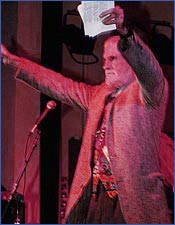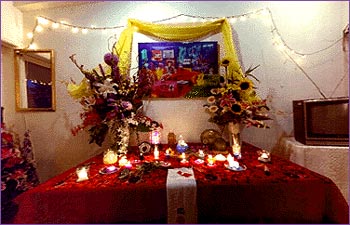Regardless of your take (and there are many), Timothy Leary will be remembered as one of the 20th century's mightiest figures. Psychologist, psychedelic rabble-rouser, zen prankster, international criminal, cyber-guru, visionary... the list could go on. Leary said it best: : "You get the Timothy Leary that you deserve." The author of such books as The Interpersonal Diagnosis of Personality (1957), The Psychedelic Experience (1964), High Priest (1968), Exo-Psychology (1977), Flashbacks (1983), Surfing the Conscious Nets (1995), among others, Timothy Leary will continue to amaze and confound us for generations to come. His legacy is well represented by his web site, which he worked on intensely before his death. I spoke with Timothy Leary by phone at his home in Beverly Hills in the fall of 1995. At the time, the hoopla surrounding his imminent "de-animation" was in full swing. He was in the upbeat process of what he called "designer dying." Leary was again smashing cultural taboos. He brought to the world a new and absolutely positive approach to the meeting with the unknown. I'd just read Chaos and Cyber Culture (Ronin Publishing, 1995) and come away with a new appreciation not only of the creative possibilities of the computer but of the sweet Chaos which we call the world.
Katzman: What higher power brought the computer into being? Leary: The brain. The brain wants light. The brain is drinking our bodies around to bring her light. We have the equipment waiting there. It's time to wake up and use it. You've said that over time this will eliminate the barriers of language that have been responsible for most war and conflict. Is this the way to a kind of global, empathetic consciousness? Absolutely. Most of the quarrels in human history are based on different language groups. Kids growing up in the 90s are going to be exposed to global information by the time they're crawling or toddling. It's all moving at light-speed, isn't it. That's been an aspiration, a hope of visionaries all the time. They want to be able to move like light. The metaphors, poetically, have been there. We're a young, a very, very young adolescent species and we're now just catching up to the fact that your body is your brain. That's important. The body is just the vehicle for your brain. Technologically, we can use that language of the brain, which are light clusters on your screen. In Chaos and Cyber-Culture you talk about the 1967 Human Be-In where you challenged a crowd of 30,000 people in Golden Gate Park to "Turn on, tune in, drop out." You call it the dawning of the psychedelic-cyber-netic age. For nearly 10 years now Michael Gosney has been holding a Digital Be-In annually in San Francisco in which you've participated. What's happening with this kind of leap? Gosney's taking that wonderful concept of the Be-In and some of the spirit of that time and bringing it to the next level of reality, which is electronic virtual reality and multimedia. Same message passed on in a better form now because when you get into electronic light media, you're working with light as a basic language. That's good. Michael's one of the few great pioneer humanists in the digital world. And our neurons need this stimulation? That's what my brain tells me. It's starved. It wants more electricity. More light. More change. She can handle a hundred and twenty-five million signals a second and I'm going along with like one...two...three...four. [laughs] Big deal. Up it. You're moving towards a transition. We all are, the human race. The tide, the surf is there. I've been surfing it. Calling your attention. Hey, look over there. The big wave's catchin' up. Get ready for it.
Photographs courtesy of Michael Gosney Up
It first appeared in Zavtone 11 (Japan, 1998) in Japanese translation. © 2000 Artzar.com - All Rights Reserved |


